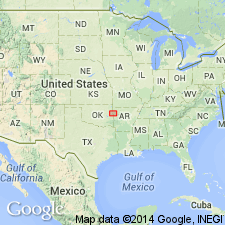
- Usage in publication:
-
- Greenleaf Lake Limestone Member*
- Modifications:
-
- Named
- Dominant lithology:
-
- Limestone
- AAPG geologic province:
-
- Chautauqua platform
- Arkoma basin
Summary:
Named as one of four members of McCully Formation. Type area is west side Arkansas River near Webbers Falls Reservoir, southeast Muskogee Co, OK. Greenleaf Lake is in TS13 and 14N, R20E. Overlies the shale "A" member and underlies the shale "B" member of the McCully. Occurs in Muskogee and Cherokee Cos, OK on the Chautauqua platform, and Sequoyah and western Adair Cos in the Arkoma basin. Consists principally of interbedded micritic, skeletal calcarenite. Wackestone is the most common; packstone is second. Skeletal grainstone of bryozoan, pelmatozoan, and algae fragments, and some oolites also present. Thin sandstone occurs near base at a few localities. Ranges from 1.6 km to 6.4 m. May be stratigraphically continuous with the Kessler Limestone Member of the Bloyd Shale of eastern Adair Co, OK and Washington Co, AR. Fossiliferous (brachiopods). Of Middle Pennsylvanian, late Morrowan age. Cross section. Stratigraphic chart.
Source: GNU records (USGS DDS-6; Denver GNULEX).
For more information, please contact Nancy Stamm, Geologic Names Committee Secretary.
Asterisk (*) indicates published by U.S. Geological Survey authors.
"No current usage" (†) implies that a name has been abandoned or has fallen into disuse. Former usage and, if known, replacement name given in parentheses ( ).
Slash (/) indicates name conflicts with nomenclatural guidelines (CSN, 1933; ACSN, 1961, 1970; NACSN, 1983, 2005, 2021). May be explained within brackets ([ ]).

